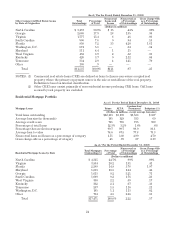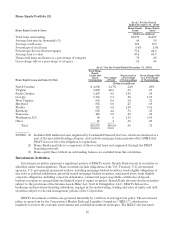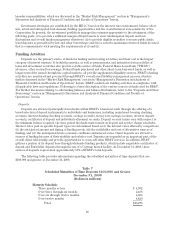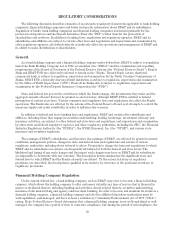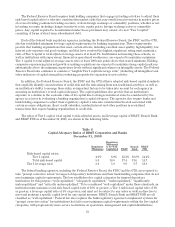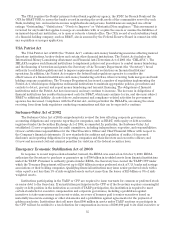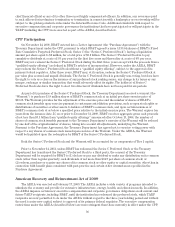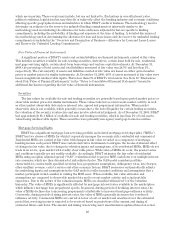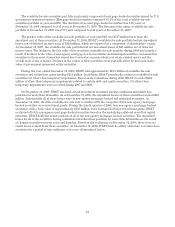BB&T 2008 Annual Report Download - page 34
Download and view the complete annual report
Please find page 34 of the 2008 BB&T annual report below. You can navigate through the pages in the report by either clicking on the pages listed below, or by using the keyword search tool below to find specific information within the annual report.according to the category in which an institution is placed. Failure to meet capital requirements also may cause
an institution to be directed to raise additional capital. Federal law also mandates that the agencies adopt safety
and soundness standards relating generally to operations and management, asset quality and executive
compensation, and authorizes administrative action against an institution that fails to meet such standards.
In addition to the “prompt corrective action” directives, failure to meet capital guidelines may subject a
banking organization to a variety of other enforcement remedies, including additional substantial restrictions on
its operations and activities, termination of deposit insurance by the FDIC and, under certain conditions, the
appointment of a conservator or receiver.
Deposit Insurance Assessments
The deposits of the Banks are insured by the DIF of the FDIC up to the limits set forth under applicable law
and are subject to the deposit insurance premium assessments of the DIF. The FDIC imposes a risk-based
deposit premium assessment system, which was amended pursuant to the Federal Deposit Insurance Reform Act
of 2005 (the “Reform Act”). Under this system, as amended, the assessment rates for an insured depository
institution vary according to the level of risk incurred in its activities. To arrive at an assessment rate for a
banking institution, the FDIC places it in one of four risk categories determined by reference to its capital levels
and supervisory ratings. In addition, in the case of those institutions in the lowest risk category, the FDIC
further determines its assessment rate based on certain specified financial ratios or, if applicable, its long-term
debt ratings. On December 16, 2008, the FDIC adopted a final rule increasing risk-based assessment rates
uniformly by 7 basis points, on an annual basis, for the first quarter of 2009. Currently, banks pay between 5 and
43 basis points of their domestic deposits for FDIC insurance. Under the final rule, risk-based rates would range
between 12 and 50 basis points (annualized) for the first quarter 2009 assessment, depending on the insured
institution’s risk category as described above. The assessment rate schedule can change from time to time, at the
discretion of the FDIC, subject to certain limits. The FDIC has published guidelines under the Reform Act on the
adjustment of assessment rates for certain institutions. Under the current system, premiums are assessed
quarterly. The Reform Act also provides for a one-time premium assessment credit for eligible insured
depository institutions, including those institutions in existence and paying deposit insurance premiums on
December 31, 1996, or certain successors to any such institution. The assessment credit is determined based on
the eligible institution’s deposits at December 31, 1996 and is applied automatically to reduce the institution’s
quarterly premium assessments to the maximum extent allowed, until the credit is exhausted. In addition,
insured deposits have been required to pay a pro rata portion of the interest due on the obligations issued by the
Financing Corporation (“FICO”) to fund the closing and disposal of failed thrift institutions by the Resolution
Trust Corporation.
On February 27, 2009, the FDIC adopted an interim rule, with request for comment, which would institute a
one-time special assessment of 20 cents per $100 of domestic deposits on FDIC insured institutions. If approved,
BB&T estimates that the assessment would total approximately $175 million. The assessment would be payable
on September 30, 2009.
Consumer Protection Laws
In connection with their lending and leasing activities, each of the Banks is subject to a number of federal and
state laws designed to protect borrowers and promote lending to various sectors of the economy and population.
These laws include the Equal Credit Opportunity Act, the Fair Credit Reporting Act, the Truth in Lending Act,
the Home Mortgage Disclosure Act, the Real Estate Settlement Procedures Act, and their respective state law
counterparts. BB&T FSB is entitled to federal preemption under the Home Owners Loan Act and OTS
regulations of certain state laws.
Federal law currently contains extensive customer privacy protection provisions. Under these provisions, a
financial institution must provide to its customers, at the inception of the customer relationship and annually
thereafter, the institution’s policies and procedures regarding the handling of customers’ nonpublic personal
financial information. These provisions also provide that, except for certain limited exceptions, an institution may
not provide such personal information to unaffiliated third parties unless the institution discloses to the customer
that such information may be so provided and the customer is given the opportunity to opt out of such disclosure.
Federal law makes it a criminal offense, except in limited circumstances, to obtain or attempt to obtain customer
information of a financial nature by fraudulent or deceptive means.
34


